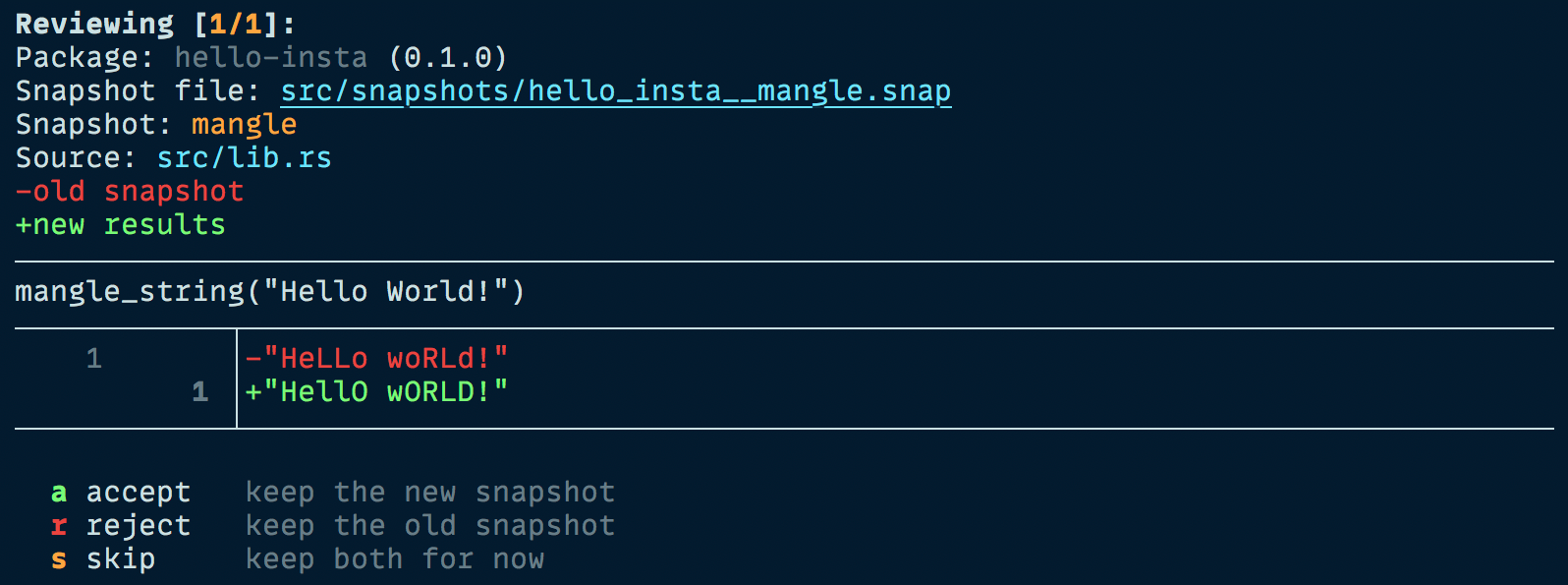Cargo Insta
Cargo Insta is the companion command line tool to assist with snapshot reviewing. It's not necessary for working with regular snapshots but it's required when working with inline snapshots.
Installation
Cargo Insta can be installed with curl to bash or powershell if you haven't yet.
On Unix (Linux and macOS):
curl -LsSf https://insta.rs/install.sh | sh
On Windows:
powershell -c "irm https://insta.rs/install.ps1 | iex"
Alternatively you can also manually install it with cargo install:
cargo install cargo-insta
You can also update it this way. After installation it becomes available as cargo insta.
Configuration
cargo-insta will load the insta.yaml config file from the workspace which
can be used to influence its behavior. For more information on this have a look
at the settings configuration.
Commands
Cargo Insta comes with a few different commands.
Common Options
--color: controls if colors should be used. The default is auto detection (auto), alternative values arealwaysandnoneto force colors on or off.--manifest-path: the path to the manifest file (Cargo.toml). If not provided the workspace is auto discovered based on the current working directory.--workspace-root: this is an alternative to--manifest-pathwhich lets you point insta directly at a workspace folder. If this parameter is used theCargo.tomlfile can be emitted in which case you can review snapshots that are placed outside of a rust package.-e/--extensions: lets you instruct cargo to consider other file extensions than.snap. This is discouraged and should only be used in certain more advanced scenarios.--include-ignored: by default cargo insta will honor common ignore files such as.gitignoreor.ignore. When this flag is passed snapshots are also discovered if they would otherwise be ignored. (Legacy alias--no-ignore)--include-hidden: by default cargo will not walk hidden folders. If this flag is provided then it will also walk into those.-q/--quiet: disables output on most commands.--help: outputs help information.--snapshot: when provided limits the operation to a single snapshot. The argument must be the canonical snapshot name which is the absolute path to the snapshot file. For inline snapshots it's the absolute path to the rust file with a colon and line number appended (eg:/foo/bar.rs:42). This parameter can be provided multiple times.--all: tells Cargo Insta to operate on all packages in a crate.
review
Review is the most important command as it can be used to review all pending snapshots. Pending snapshots are snapshots that changed from the stored reference during a test run.
It scans for all non ignored snapshots (optionally filtered down to individual
snapshots with --snapshot) and then walks you through all of them. For each
snapshot change a diff is shown. To accept a snapshot change press a, to
reject r and to skip for now use s. Diffs can be turned on and off with d
and auxiliary information can be shown or hidden with i.

When you skip the new snapshot file will be left behind.
accept
This operates exactly like review but instead of an interactive review
all snapshot changes will be accepted.
reject
This operates exactly like review but instead of an interactive review
all snapshot changes will be rejected.
pending-snapshots
This command returns a list of all snapshots that need reviewing. This is useful when you want to provide editor integrations for insta. For instance this is how the VS Code extension shows the list of pending snapshots.
When JSON output is used the old and new contents of inline snapshots are also returned.
Options:
--as-json: output the value as JSON instead of human readable.
test
The test command lets you execute all tests (similar to cargo test) but
forces all snapshot tests to pass so that they are collected. It accepts
the same arguments as the normal cargo test command.
Additionally extra comments can be passed to cargo test when separated
with --.
Options:
-p/--package: selects the package to run tests for.--no-force-pass: disables the default behavior that forces all snapshot tests to pass.--features: space-separated list of features to activate.--all-features: activate all available features--no-default-features: do not activate thedefaultfeature--review: automatically follow up with snapshot review after test run.--accept: automatically accept all snapshots after test run.--accept-unseen: like--acceptbut only accept all new (previously unseen) snapshots.--keep-pending: do not reject pending snapshots before run.--force-update-snapshots: update all snapshots even if they are still matching. This is useful if insta changed the metadata format.--unreferenced: controls what should happen with unreferenced snapshots. The default isignore. Valid values areignore,warn,reject,deleteandauto.warnwill emit a warning if there are unreference snapshots,rejectwill error.deletewill delete unreferenced snapshots after the test run. Finallyautobehaves likerejectin CI and likedeleteif not run from CI.--glob-filter: Filters to apply to the insta glob feature--test-runner: Selects a different test runner (cargo-testornextest)
Some other options are directly mirrored from cargo test.